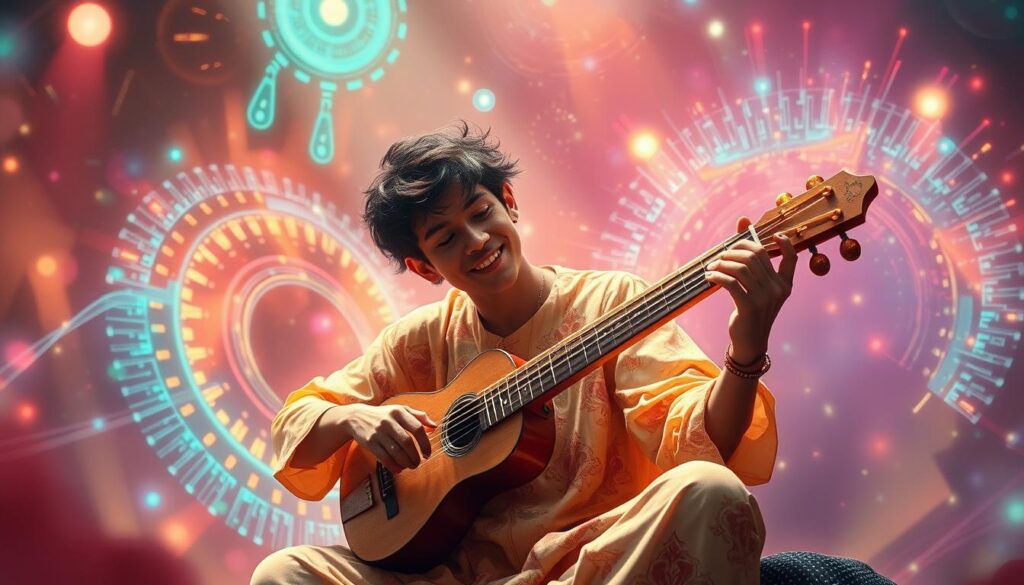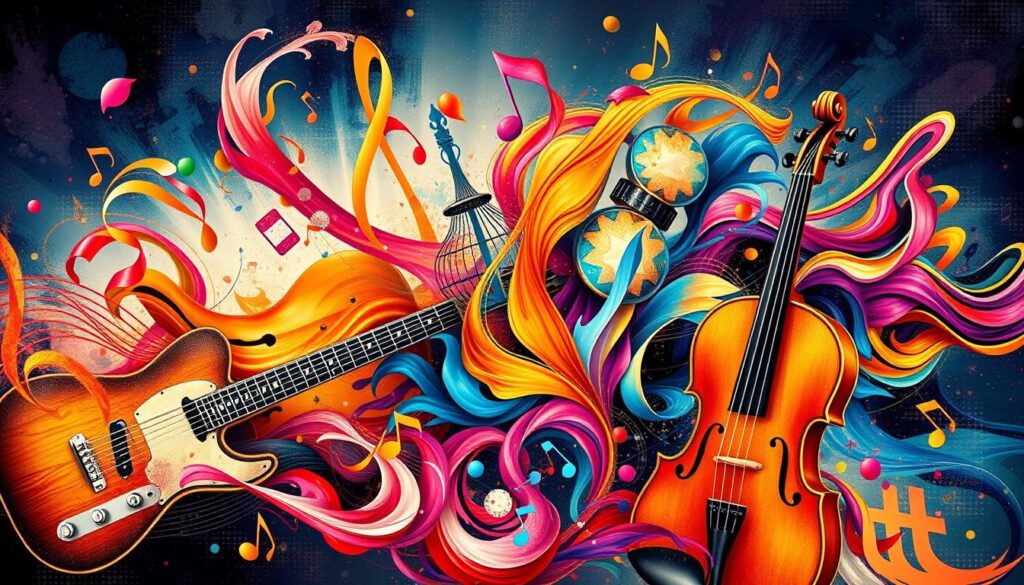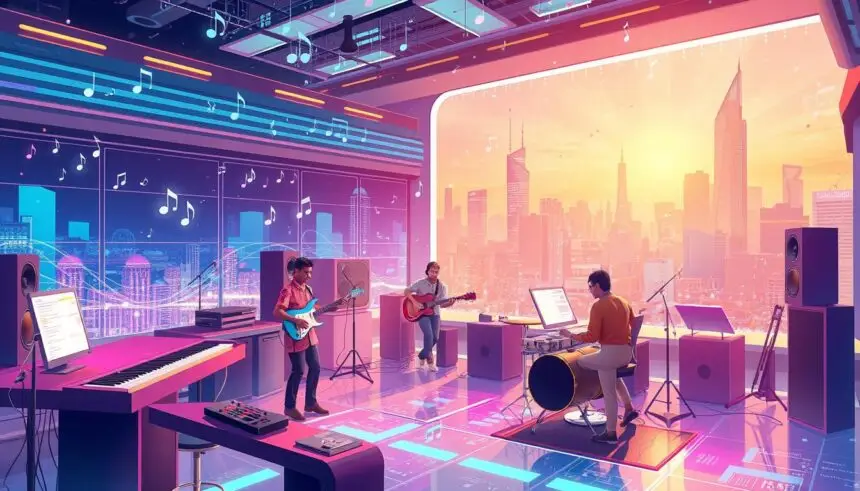I’ve always loved the magic of music made by humans. With AI and digital tools taking over, keeping music real and emotional seems hard. But, we must keep the human touch alive. It’s what makes music truly special. Human Music in an AI World
This guide will show how to mix human creativity with AI. We’ll look at ways to make music that touches the heart. We’ll explore new tools and methods, and how to use AI to help, not replace, our music.
Key Takeaways
- Understand the impact of AI on traditional music making and the current state of human-AI interaction
- Explore essential tools and techniques for modern human music creation, including digital audio workstations and hybrid production methods
- Learn how to balance technology and human creativity to find your authentic musical voice in the digital era
- Discover strategies for effectively collaborating with AI systems while maintaining artistic control
- Gain insights on navigating the music industry’s increasing integration of AI and preserving emotional connection with listeners

Understanding the Current Music Landscape in the Age of AI
The music world has changed a lot, thanks to new tech in music making. Now, we see a mix of human creativity and AI shaping music’s future.
The Evolution of Music Production Technology
Music production has moved from old analog ways to new digital ones. Tools like digital audio workstations (DAWs) and virtual instruments have changed the game. They let artists control their work more, leading to new sounds and ideas.
Impact of AI on Traditional Music Making
AI has changed how we make music. It helps with things like making melodies and arranging songs. This has made artists think differently about what makes music “human.”
Current State of Human-AI Musical Interaction
The mix of human and AI music making is still growing. Some artists see AI as a way to improve their work. But others worry about losing the human touch in music.
| Music Production Technology Timeline | Key Advancements |
|---|---|
| 1980s | Introduction of MIDI (Musical Instrument Digital Interface) |
| 1990s | Rise of digital audio workstations (DAWs) and virtual instruments |
| 2000s | Advancements in sound-editing software and cloud-based collaboration tools |
| 2010s | Emergence of AI-powered music composition and production tools |
“The integration of AI into the music industry has been a game-changer, challenging our traditional notions of what it means to be a ‘composer’ or ‘producer’.”
Making Human Music in an AI World: Finding Your Authentic Voice
In today’s world, where AI is changing music fast, it’s key to keep your artistry real. You need to balance working with AI and staying true to your music. This balance is what makes your music stand out.
AI can help with making music, from starting ideas to creating sounds. But, it’s important not to lose the emotional and personal touch that makes your music special. To keep your music human, you must know who you are as an artist and stick to your vision.
Cultivating Your Artistic Signature
Finding your true voice in a world of changing tech is a journey. Take time to understand what makes your music unique. This includes your influences and the feelings you want to share through your music. By focusing on these, you can use AI tools without losing your artistic identity.
Blending AI and Human Creativity
You don’t have to give up control when using AI tools. See them as tools to help you, not replace you. Use them to make your music better, but always keep your human touch. This way, your music stays true to you.
Prioritizing Emotional Connection
Even with AI, connecting with your audience on a deep level is crucial. Your music should have real energy, stories, and feelings. This human touch makes your music special and connects with listeners in a way that technology can’t.
As music evolves, working with AI and staying true to yourself is key. By blending AI with your creativity, you can make music that celebrates human expression in a world of automation.
Essential Tools for Modern Human Music Creation
Technology has changed the music world a lot. Now, music makers have new tools like digital audio workstations (DAWs) and digital instruments. These changes make music creation more exciting and flexible than before.
Digital Audio Workstations (DAWs)
DAWs are key for making and producing music today. Pro Tools, Logic Pro, and Ableton Live are popular. They let musicians record, sequence, and mix music in new ways.
These tools help mix digital and analog sounds. This opens up new creative paths for musicians.
Traditional Instruments in the Digital Age
Even with new tech, traditional instruments are still important. Musicians are finding new ways to use guitars, pianos, and drums with digital tools. This mix keeps the real sound of instruments while using digital tools’ flexibility.
Hybrid Production Techniques
- Blending live recordings with virtual instruments and samples
- Utilizing AI-powered music generation tools to spark creative ideas
- Experimenting with real-time digital effects and processing
- Integrating traditional instrumentation with cutting-edge production software
Using a mix of old and new, musicians can keep their music real and fresh. This way, they can connect with listeners in a special way. It’s a balance between tech and the true art of music.
| Digital Audio Workstation (DAW) | Key Features | Pricing |
|---|---|---|
| Pro Tools | Multi-track recording, MIDI sequencing, advanced mixing and mastering | $29.99/month (annual subscription) |
| Logic Pro | Comprehensive music production suite, seamless integration with Apple ecosystem | $199.99 (one-time purchase) |
| Ableton Live | Innovative workflow, live performance capabilities, audio/MIDI manipulation | $449 (one-time purchase) |
Balancing Technology and Human Creativity
In the world of music production, finding the right mix of new tech and human touch is key. As creative expression and human-machine collaboration grow closer, artists face a big challenge. They must keep their unique vision alive amidst all the tech.
AI and digital tools have changed music-making a lot. They help with everything from making melodies to mixing sounds. But, artists must use these tools wisely to keep their music feeling real and emotional.
| Key Considerations | Strategies for Balance |
|---|---|
| Avoiding Overreliance on Technology | Judiciously incorporating AI and digital tools, while ensuring they serve as creative enhancers rather than replacements for human input and intuition. |
| Preserving the Human Touch | Prioritizing the use of traditional instruments, live performances, and manual processing techniques to imbue music with a palpable sense of human expression. |
| Nurturing Emotional Connection | Consciously focusing on crafting music that resonates emotionally with listeners, even as technological advancements shape the production process. |
By finding a balance between creative expression and human-machine collaboration, artists can use tech to improve their work. Yet, they must not lose sight of what makes music special.
“The most exciting phrase to hear in science, the one that heralds new discoveries, is not ‘Eureka!’ but ‘That’s funny…'” – Isaac Asimov
The music world is always changing, and artists must learn to blend human and digital elements. This balance will lead to new creative heights and deeper connections with fans.
Leveraging AI as a Creative Assistant
In today’s fast-changing music world, artificial intelligence (AI) is a big help for artists and producers. It offers tools for making music, arranging, and mixing. This tech could change how we create music.
AI-Powered Music Generation Tools
Thanks to machine learning, AI tools can help artists make new music. These tools learn from lots of music and create original sounds. They help artists explore new ideas and improve their work.
Using AI for Arrangement and Mixing
AI is also changing how we arrange and mix music. It can analyze music and suggest ways to make it sound better. This lets artists work smarter, not harder, and focus on their vision.
Maintaining Creative Control
It’s important for artists to keep control when using AI. By using AI wisely, artists can enhance their work without losing their unique touch. This way, AI helps, but doesn’t take over the creative process.
“The key is to view AI as a collaborator, not a replacement. By working in harmony with these advanced technologies, we can unlock new realms of musical expression while preserving the authenticity and emotion that are the hallmarks of great music.”
Developing Your Unique Sound in the Digital Era
In today’s music world, where AI changes how we create, keeping your creative expression is crucial. As an artist, having a unique sound helps you stand out. This is especially true in a world filled with music made by machines.
Start by looking at what influences you and your culture. Let your creative expression lead your music-making. Mix traditional sounds with new digital tools to make music that’s truly yours.
It’s important to balance new tech with the human touch in music. Use digital tools, but keep your personal feelings and real expression in your music. This way, you keep the heart of human artistry alive.
“The most powerful music is often that which seamlessly combines the digital and the analog, the human and the machine, into a cohesive and captivating sonic experience.”
Your unique sound shows who you are as an artist. Use digital tools, but always remember what makes your music special. This balance lets your music connect with people, keeping human artistry alive in the AI age.

Collaboration Strategies: Humans and Machines
In the world of music, humans and AI tools work together more than ever. It’s important to find ways to work well together. This means making the most of both sides, keeping creativity flowing, and staying true to the art.
Building Effective Workflows
Creating a smooth workflow is key. It’s about knowing what each side does best and working together smoothly. AI can speed up tasks, but humans bring the soul and vision. This mix leads to better music and new ideas.
Creative Partnership with AI
Working with AI is more than just using tools. It’s about a real partnership. AI can bring new ideas and help shape music. Humans add the heart and direction. Together, they create something special.
Maintaining Artistic Integrity
As AI becomes more common in music, keeping art true is vital. The human artist should always be in charge. This way, the music stays real and connects with listeners on a deep level.
| Collaboration Strategies | Key Considerations |
|---|---|
| Building Effective Workflows | Identify strengths of human and machine; streamline creative process; establish clear communication |
| Creative Partnership with AI | Embrace AI capabilities for novel ideas and optimization; maintain human artistic direction |
| Maintaining Artistic Integrity | Ensure human artist retains creative control; balance human-machine collaboration; preserve unique artistic voice |
Exploring these strategies helps musicians use technology wisely. It keeps their music real and touching. This way, they can make the most of both worlds.
Navigating the Music Industry’s AI Integration
The music industry is changing fast, with artificial intelligence (AI) playing a big role. Music industry trends and technological disruption are making big waves. They bring both challenges and chances for success in the digital world.
AI is changing how music is made, shared, and listened to. It’s making it easier for musicians to work on their music, but it also makes us wonder about the role of the human artist. This is a big change.
- AI tools are letting artists try new sounds, but keeping their unique touch is key.
- AI music suggestions are changing how we find new tunes, but connecting with fans is still important.
- Blockchain and AI are shaking up how music makes money, offering both chances and hurdles for artists.
To do well in this new world, artists need to adjust and use AI wisely. Working with AI tools, having a strong online presence, and finding new ways to make money are crucial. These steps will help artists succeed in the future.
“The music industry is at a crossroads, where the rapid pace of technological change is both empowering and disruptive. Artists who can navigate this landscape and find the right balance between human creativity and AI-driven innovation will be poised for success.”
As the music world keeps changing, artists must embrace AI while keeping music human. By keeping up with trends and adjusting their plans, musicians can face challenges and seize the benefits of technology. This will help them stay relevant in the music world’s constant evolution.
Preserving Human Expression in Automated Environments
In today’s world, AI is changing how we make music. The big challenge is keeping the human creative expression and preserving human artistry alive. It’s important to keep the emotional connection and personal touch in music, even with new tech.
Emotional Connection in Music
Music can make us feel deeply, from happiness to sadness. We might forget the human side when chasing perfection. Adding personal stories and feelings into music can connect artists with their fans in a special way.
The Human Touch in Production
AI can make music production faster and more precise. But, nothing beats the human touch. Small mistakes and personal touches make music real and meaningful. Mixing tech with human artistry creates something truly special.
Building Authentic Connections with Listeners
In a digital world, connecting with fans is harder. But, artists can stand out by sharing their stories and feelings. This way, they can touch listeners’ hearts and minds, beyond just tech.
The music world is always changing. Artists must keep their human artistry alive. By balancing tech and human emotion, music can stay vibrant and meaningful, even with more automation.
Future-Proofing Your Musical Career
The music industry is changing fast with the help of artificial intelligence. Musicians need to keep up and make their careers future-proof. It’s all about using new tech while staying true to your art.
Start learning more about music production software and AI tools. See how they can help you create better music. Being open to new ideas will help you stay ahead in the fast-paced music world.
But don’t forget, music is all about the human touch. Using technology can make your music even better. It lets you share your vision with your fans in a new way. This is your chance to lead the music world into the future.
FAQ
What is the current state of human-AI musical interaction in the music industry?
The music world has changed a lot with AI. It has brought new tools for making music. But, it also makes us wonder if music still feels real and emotional.
Now, we see a mix of using AI’s power and keeping human touch in music. It’s a tricky balance.
How can musicians maintain their authentic voice in an AI-dominated music landscape?
Keeping true to oneself is key in the AI era. Musicians can mix their creativity with AI tools. They should focus on emotional and cultural depth in their music.
Creating a unique sound that goes beyond tech is important. It’s about finding a balance between new ideas and staying true to oneself.
What are some essential tools for modern human music creation?
Today’s music makers use digital audio workstations (DAWs) a lot. These tools help with recording, editing, and mixing.
Also, mixing old instruments with new tech is common. Using AI for tasks like arranging and mixing can help too.
How can musicians effectively collaborate with AI in the creative process?
Working well with AI is key for musicians today. They need to find ways to work together smoothly. This means using AI as a helper, not a replacement.
AI can assist with making music, but the artist should always be in charge. This way, the music stays true to the artist’s vision.
What are the ethical considerations when using AI in music production?
Using AI in music raises big questions about who owns the music and its soul. Artists must be careful not to lose their touch in the process.
They should talk openly about AI’s role and not rely too much on it. Keeping a unique sound is crucial.
How can musicians adapt and future-proof their careers in an AI-driven music industry?
Musicians need to keep learning and be open to new tech. They should try out AI tools and stay up-to-date with trends.
Having a wide range of skills helps them stay relevant. By using AI wisely, they can keep their music real and stay successful.



